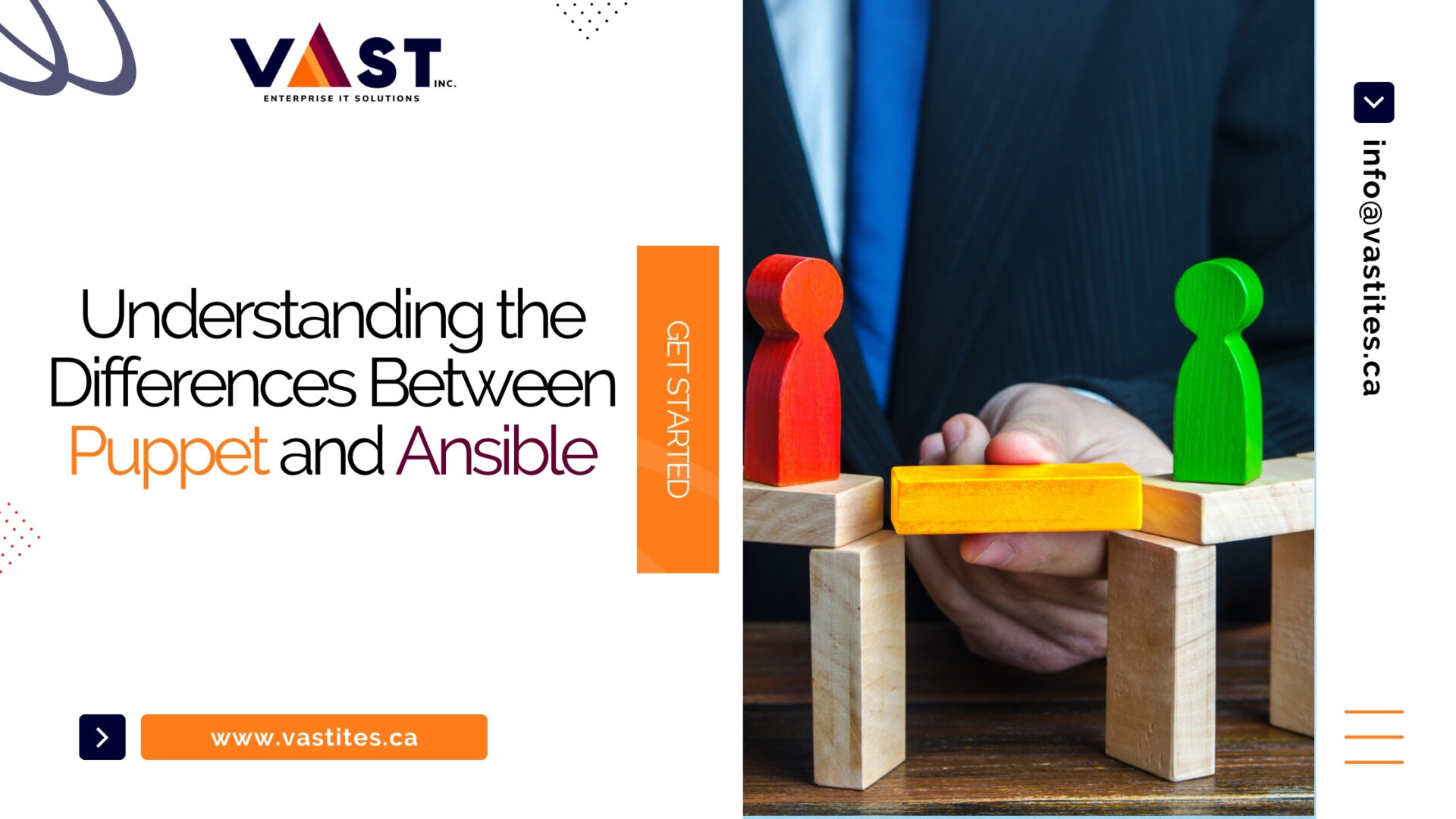
- January 31, 2024
- vastadmin
- 0
In the ever-changing environment of IT automation, Puppet and Ansible stand out as two significant players, each with their own approach to configuration management. In this blog post, we’ll look at the fundamental distinctions between Puppet and Ansible, allowing you to make informed decisions about your automation journey.
Unveiling Puppet, the Configuration Management Veteran h
Understanding Puppet
Puppet is a well-known configuration management tool. It takes a declarative approach, allowing customers to specify the desired state of their infrastructure. Puppet articulates configurations using a domain-specific language (DSL), which ensures system consistency.
Key Features of Puppet
Declarative Language
Puppet’s declarative language is an impressive feature. Users define the desired end state, while Puppet handles the underlying steps to reach it. This abstraction simplifies configuration management, making it more accessible to a diverse variety of users.
Agent-Based Architecture.
Puppet uses an agent-based approach, which means that nodes have Puppet agents installed. The agents communicate with the Puppet master server to retrieve and apply configurations to the nodes. This architecture establishes a centralized control point.
Unraveling Ansible: The Agentless Challenger
Understanding Ansible
Ansible, on the other hand, takes a different approach and adopts an agentless design. It uses a procedural language and configures using YAML (Yet Another Markup Language). Ansible users define tasks and playbooks to attain their desired state.
Key Features of Ansible
Agentless Model
Ansible’s agentless architecture removes the need for agents on managed nodes. Instead, it communicates via SSH, which makes it easier to set up and administer. This agentless technique is especially appealing for contexts where installing agents is difficult.
YAML playbooks
Ansible uses YAML playbooks to define automation tasks. The simplicity of YAML makes it human-readable and writable, allowing for simple cooperation among team members. Ansible’s playbooks offer a clear format for defining configurations.
Key Differences Between Puppet and Ansible
- Architecture.
Puppet: Agent-Based
Puppet has a client-server architecture, with agents installed on nodes. Nodes communicate with the Puppet master server to retrieve configurations.
Ansible: agentless
Ansible uses an agentless paradigm and communicates with managed nodes over SSH. This eliminates the requirement to install agents on the target systems.
- Learning Curve
Puppet: Declarative Language
Puppet’s declarative language may have a higher learning curve for newbies. Understanding the DSL and defining configurations take some amount of skill.
Ansible: YAML playbooks
Ansible’s YAML playbooks are reasonably simple to learn and understand. The procedural method is more user-friendly for those who are unfamiliar with a certain language.
- Flexibility and Extensibility
Puppet: Extensive module ecosystem
Puppet has a robust module ecosystem that includes pre-built setups for users to use. This enhances Puppet’s flexibility and extensibility.
Ansible: Ad Hoc Commands
Ansible allows users to perform ad-hoc commands, giving them more flexibility in executing activities without the requirement for established playbooks. However, its module ecology may be less diverse than Puppet’s.
Finally, the decision between Puppet and Ansible is based on your organization’s unique requirements, preferences, and current infrastructure. Puppet’s declarative language and agent-based paradigm form a solid foundation for configuration management, whereas Ansible’s agentless and procedural approach appeals to those who want simplicity and quick adoption.
Understanding the subtleties of Puppet and Ansible enables you to make informed decisions about how to align your automation approach with your organization’s goals.
FAQ: Navigating Further Insights
Q1: Which is better for beginners: Puppet or Ansible?
A: Ansible is frequently seen as more beginner-friendly owing to its YAML playbooks and agentless paradigm, which make it easier to learn and implement.
Q2: Is one better than the other, or does it depend on the use case?
A: The decision between Puppet and Ansible is based on your organization’s tastes, current infrastructure, and specific use cases. Both have advantages and are commonly employed in various contexts.
Q3: Can Puppet and Ansible be combined in a hybrid approach?
A: Yes, some organizations use a hybrid strategy, combining Puppet and Ansible based on their capabilities and compatibility with various components of their infrastructure.
